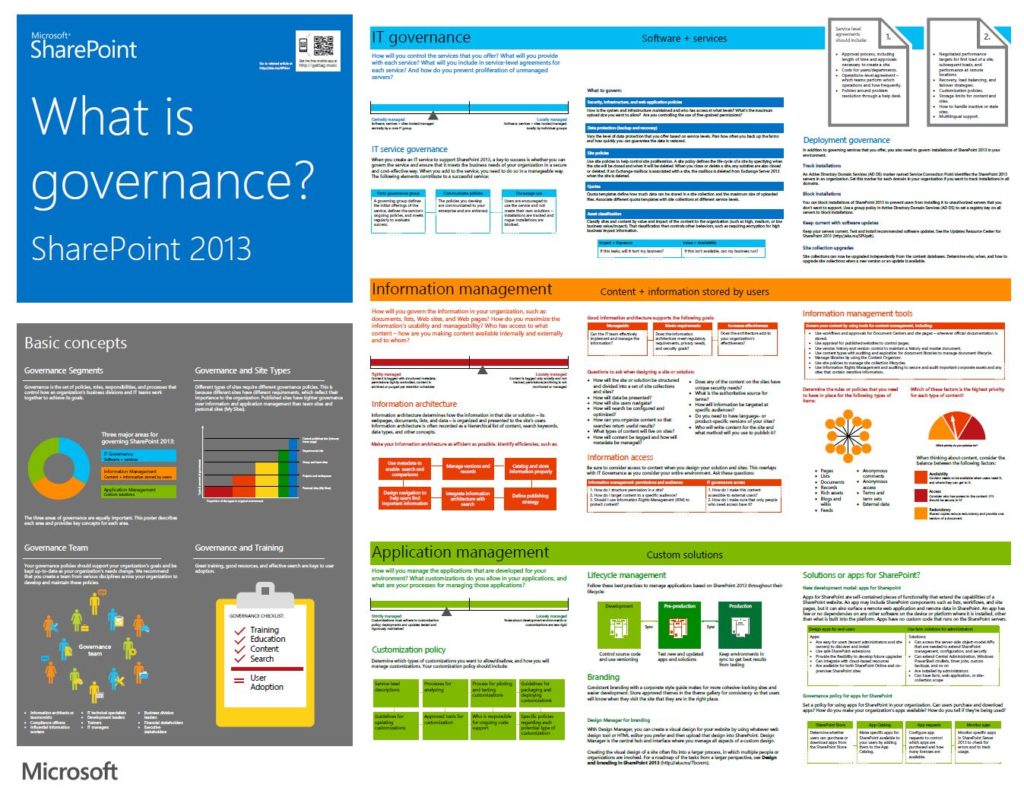Intranet governance details the ownership model (who owns and manages it), and the rules for creating pages and content (roles and responsibilities, and policies); SharePoint intranet governance is really no different than the standard intranet governance model, though it does require some special attention with respect to site creation.
SharePoint is appreciated for its simplicity of use out-of-the-box, though derided for problems (and the expenses) customizing the user experience (design, navigation and information architecture).
SharePoint is replete with functionality and applications, and is the most comprehensive intranet development platform on the market. It is, unfortunately, expensive, and most of the feature set that we use, and that our clients use, fall short of expectations, and often below best-of-breed. SharePoint 2013 isn’t a niche product that is supposed to be superb at web content management, or social networking; it’s a broad solution, one that has something for everybody; a solution that can please some, but not all. However, SharePoint 2013 was much improved over its predecessor, but left little to be desired for mobile users.
SharePoint 2016 is greatly improved for mobile users — responsive design, and a mobile app. It’s enterprise search is superb, and there’s great improvement in the social experience using Delve and Yammer. However, SharePoint 2016, and the SharePoint Online with Office 365, was three years in the making, has few improvements to the web content management experience, and very few have yet to implement it.
SharePoint is part enterprise content management (ECM) solution, part portal solution, part web development platform, part social media platform. It offers many, many solutions and functions – often too much for most organizations – but it is Microsoft’s hope that it will become everything to everybody including the de facto platform for the company intranet, website(s) and extranet(s). In sum total, it is an amazingly powerful solution, but often fails to live up to expectations.
From a governance perspective, the governance criticism of SharePoint is unfounded. For all its strengths and weaknesses, SharePoint is fairly strong for governance when compared to other platforms. It is not perfect, but no solution is, and governance is largely independent of technology — it’s all about people and process.
Like the content of your website or intranet, planning and governance is technology agnostic; whether it’s SharePoint or another intranet technology platform, the necessity for and the approach to governance is the same. In short, governance lives and dies with its people, specifically the owner (and the rules they put in place, regardless of the technology).
When building a governance model for SharePoint, the major components should include:
- The umbrella ownership model – Centralized? Decentralized? Collaborative?
- Defined ownership structure (names and titles)
- Roles and responsibilities (jobs and duties)
- Decision making process (who is responsible for what and when)
- Authorization (who is responsible for what and when)
- Policy (what is allowed, and what is not allowed)
While governance is highly specific and custom to the individual organization, and its culture and people — regardless of the technology — there are some issues specifically related to SharePoint that are worth noting, particularly around the deployment of team or collaboration sites. Any person creating or deploying such a site should sign-off on a set of rules, and should be forced to renew or delete collaboration sites every six or twelve months.
In general though, the three most important governance requirements every intranet should have:
- Detailed ownership structure with names attached to each role, including executive champions
- Every page should have an owner, with the owner’s name and email automatically applied to each page
- Every page requires a very strong header that most accurately describes the content, and an expiry date
These issues and others are discussed in-depth including, SharePoint governance, and some of the specific, requisite steps and policies for implementing intranet and in the SharePoint Governance white paper.
Many world-class intranets and digital workplaces, including those from Google, Coca-Cola, Bayer, and others, with detailed case studies are presenting at this year’s Digital Workplace & Intranet Global Forum conference in New York (Oct. 25 – 26). Early-bird registration is only $890 for the full conference.
Want more intranet articles and case studies? SUBSCRIBE TO THE FREE INTRANET INSIGHT NEWSLETTER
